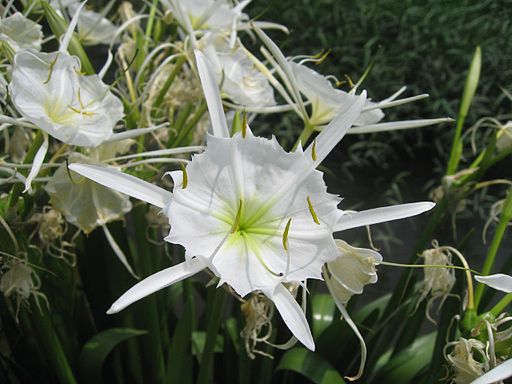Classification System: APG IV
Superregnum: Eukaryota
Regnum: Plantae
Cladus: Angiosperms
Cladus: Monocots
Ordo: Asparagales
Familia: Amaryllidaceae
Subfamilia: Amaryllidoideae
Tribus: Hymenocallideae
Genus: Hymenocallis
Species: Hymenocallis coronaria
Name
Hymenocallis coronaria (Leconte) Kunth, 1850.
Synonyms
Basionym
Pancratium coronarium Leconte, Ann. Lyceum Nat. Hist. New York 3: 145. 1836.
Homotypic
Tomodon coronarium (Leconte) Raf., Fl. Tellur. 4: 22. 1838.
Distribution
Native distribution areas:
Hymenocallis coronaria
Continental: Northern America
Regional: Southeastern USA
Alabama; Georgia; South Carolina
References: Brummitt, R.K. 2001. TDWG – World Geographical Scheme for Recording Plant Distributions, 2nd Edition
References
Kunth, C.S. 1850. Enumeratio Plantarum Omnium Hucusque Cognitarum, Secundum Familias Naturales Disposita, Adjectis Characteribus, Differntiis et Synonymis. Stutgardiae et Tubingae 5: 855.
Links
Govaerts, R. et al. 2018. Hymenocallis coronaria in World Checklist of Selected Plant Families. The Board of Trustees of the Royal Botanic Gardens, Kew. Published on the internet. Accessed: 2018 Aug. 01. Reference page.
International Plant Names Index. 2018. Hymenocallis coronaria. Published online. Accessed: Aug. 01 2018.
Tropicos.org 2018. Hymenocallis coronaria. Missouri Botanical Garden. Published on the internet. Accessed: 2018 Aug. 01.
Vernacular names
English: Shoals spiderlily
Hymenocallis coronaria, commonly known as the Cahaba lily, shoal lily, or shoals spider-lily, is an aquatic, perennial flowering plant species of the genus Hymenocallis. It is endemic to the Southeastern United States, being found only in Alabama, Georgia, South Carolina and parts of North Carolina.[2][3] Within Alabama, it is known as the Cahaba lily; elsewhere it is known as the Shoal lily or Shoals spider-lily.[4]
Description and habitat
Hymenocallis coronaria requires a swift, shallow, water current and direct sunlight to flourish.[5] The plant grows to about 3 feet (0.9 m) tall and develops from a bulb that lodges in cracks in rocky shoals.[6] It blooms from early May to late June.[5] Each fragrant flower blossom opens overnight and last for one day. They are visited and possibly pollinated by Paratrea plebeja, commonly known as the plebeian sphinx moth, and Battus philenor, the pipevine swallowtail butterfly.[7]
The plant was first observed in 1783 by William Bartram and described as the "odoriferous Pancratium fluitans which almost alone possesses the little rocky islets". He saw it growing in the Savannah River near Augusta, Georgia.[8]
Populations
Hymenocallis coronaria is under consideration for protection under the Endangered Species Act, due to entire populations being wiped out by dam construction.[8] There are only approximately 50 extant populations of Hymenocallis coronaria left, all in the states of Alabama, Georgia, and South Carolina. The three largest remaining populations are located in the Cahaba River in Alabama, the Catawba River in South Carolina, and in the Flint River in Georgia.[7] The Cahaba River has four separate populations, with three within the Cahaba River National Wildlife Refuge and one in Buck Creek); the Catawba has one within the Landsford Canal State Park; and the Flint has four, from Yellow Jacket Shoals to Hightower Shoals. Significant populations remain in the Savannah River basin, with three in the main channel and one each in the tributaries of Stevens Creek in South Carolina and the Broad River in Georgia.[7] Efforts are currently underway to establish populations along the Chattahoochee River along the whitewater course in Columbus. The project involves collecting seeds from native stands along a section of Flat Shoals Creek, a tributary to the Chattahoochee. Seeds are collected and germinated, and then grown to establish hardy root systems. After a year they are planted along the river in areas where habitat is prime.
A stand of H. coronaria in the Cahaba River in Alabama
In Vietnam
References
"Hymenocallis coronaria". World Checklist of Selected Plant Families. Royal Botanic Gardens, Kew. Retrieved 2014-04-02.
Kew World Checklist of Selected Plant Families
Biota of North America Program 2013 county distribution map
Davenport, L. J. "Cahaba lily". Encyclopedia of Alabama. Retrieved 2008-10-08.
"About the Cahaba Lily". CahabaLily.com. Archived from the original on 2008-05-16. Retrieved 2007-12-16.
"The Cahaba Lily". Cahabariver.net. Retrieved 2007-12-16.
Markwith, Scott H.; Scanlon, Michael J. (May 11, 2006). "Multiscale analysis of Hymenocallis coronaria (Amaryllidaceae) genetic diversity, genetic structure, and gene movement under the influence of unidirectional stream flow". American Journal of Botany. Botanical Society of America. PMID 21642217. Retrieved October 1, 2012.
"Hymenocallis coronaria in Flora of North America". eFloras.org. Retrieved 2007-12-16.
Retrieved from "http://en.wikipedia.org/"
All text is available under the terms of the GNU Free Documentation License


